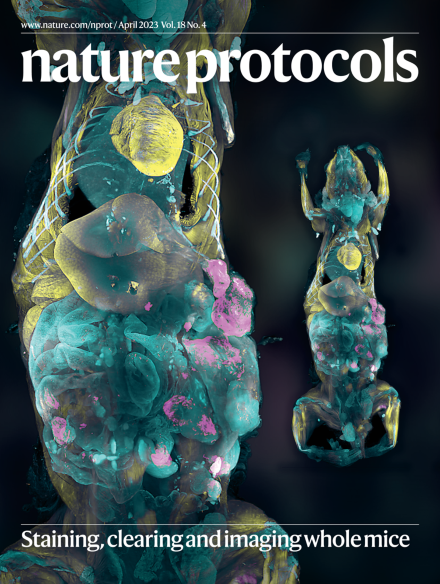通过胚胎着床前培养和体细胞重编程建立人类扩展潜能干细胞系。
IF 16
1区 生物学
Q1 BIOCHEMICAL RESEARCH METHODS
引用次数: 0
摘要
我们之前报道了通过调节涉及着床前胚胎发生的信号通路来衍生扩增的潜在干细胞(EPSCs)。这些细胞表现出扩展到胚胎和胚胎外谱系的发育潜力,我们已经证明人类EPSCs (hEPSCs)具有分化滋养层的能力,可以产生人类滋养层干细胞。在这里,我们报告了直接从人类着床前胚胎(hEPSC-em)的桑葚胚或早期囊胚阶段获得稳定的hEPSC系,并使用六种外源因子对人类真皮成纤维细胞(人诱导的EPSCs)进行重编程的方案,作为我们之前从着床前胚胎获得猪EPSCs和通过体细胞重编程的方案的延伸。这些hEPSC细胞系在长期传代中增殖强劲,并且适合简单的索引和精确的基因组编辑。我们为这些新建立的hEPSCs的表征提供指导,包括细胞周期分析、多能性验证和核型分析。hEPSCs具有胚胎和胚胎外细胞系形成畸胎瘤,并且在体外很容易分化为人类滋养细胞干细胞。在分子水平上,hEPSCs具有独特的特征,如核心组蛋白基因的高表达和类似于8细胞/桑葚胚的低H3K27me3水平。这些特性使hEPSCs不仅成为研究早期人类发育的宝贵工具,而且在再生医学中也有潜在的应用。本文中提出的方案可以很容易地由研究生或博士后执行,并在2个月内完成。本文章由计算机程序翻译,如有差异,请以英文原文为准。

Establishment of human expanded potential stem cell lines via preimplantation embryo cultivation and somatic cell reprogramming
We previously reported the derivation of expanded potential stem cells (EPSCs) by modulating signaling pathways involved in preimplantation embryogenesis. These cells exhibit expanded developmental potential into embryonic and extraembryonic lineages, and we have shown that human EPSCs (hEPSCs) possess trophoblast differentiation potency for generating human trophoblast stem cells. Here we report protocols for deriving stable hEPSC lines directly from morula or early blastocyst stages of human preimplantation embryos (hEPSC-em) and by reprogramming human dermal fibroblasts (human induced EPSCs) using six exogenous factors, as an extension to our previous protocols on deriving porcine EPSCs from preimplantation embryos and by reprogramming somatic cells. These hEPSC lines proliferate robustly over long-term passaging and are amenable to both simple indels and precision genome editing. We provide guidance for characterizing these newly established hEPSCs, including cell-cycle analysis, pluripotency validation and karyotyping. The hEPSCs form teratomas with embryonic and extraembryonic cell lineages and readily differentiate into human trophoblast stem cells in vitro. At the molecular level, hEPSCs have unique features such as high expression of core histone genes and low H3K27me3 levels resembling eight-cell/morula stage embryos. These properties make hEPSCs a valuable tool not only for studying early human development but also for potential applications in regenerative medicine. The protocols presented in this manuscript can be readily performed by postgraduate students or postdoctoral fellows and completed within around 2 months. This is a Protocol extension describing the establishment of human expanded potential stem cell lines from preimplantation embryos or by reprogramming somatic cells and their validation and characterization.
求助全文
通过发布文献求助,成功后即可免费获取论文全文。
去求助
来源期刊

Nature Protocols
生物-生化研究方法
CiteScore
29.10
自引率
0.70%
发文量
128
审稿时长
4 months
期刊介绍:
Nature Protocols focuses on publishing protocols used to address significant biological and biomedical science research questions, including methods grounded in physics and chemistry with practical applications to biological problems. The journal caters to a primary audience of research scientists and, as such, exclusively publishes protocols with research applications. Protocols primarily aimed at influencing patient management and treatment decisions are not featured.
The specific techniques covered encompass a wide range, including but not limited to: Biochemistry, Cell biology, Cell culture, Chemical modification, Computational biology, Developmental biology, Epigenomics, Genetic analysis, Genetic modification, Genomics, Imaging, Immunology, Isolation, purification, and separation, Lipidomics, Metabolomics, Microbiology, Model organisms, Nanotechnology, Neuroscience, Nucleic-acid-based molecular biology, Pharmacology, Plant biology, Protein analysis, Proteomics, Spectroscopy, Structural biology, Synthetic chemistry, Tissue culture, Toxicology, and Virology.
 求助内容:
求助内容: 应助结果提醒方式:
应助结果提醒方式:


